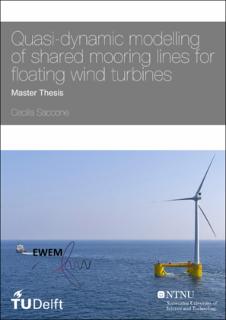| dc.description.abstract | The idea of shared mooring systems has been introduced in the offshore wind farm industry as an effort to lower the overall installation costs for floating offshore wind farms. The reason for building such plants is that using floating turbines allows them to move to deeper waters, reducing visual and environmental impact and allowing footprint reduction, with the downside being an increase in the total installation costs.
Because shared mooring lines create couplings between neighbouring turbines, the use of shared mooring lines adds complexity to the design and modelling of offshore floating wind farms. So far, these systems have been investigated and analyzed using either quasi-static or fully dynamic models. With the goal of using a method that can be more accurate in terms of dynamic behavior of the mooring lines than the quasi-static one and less time-consuming than the fully dynamic one by using a system with less degrees of freedom, this project seeks to further explore the idea of shared mooring lines within a quasi-dynamic model.
A quasi dynamic system is not as complex as the dynamic model but more rigorous than the quasi-static one because it includes terms related to the drag and inertia of the mooring lines. Inertial loads on mooring lines can alter the tension of the mooring line at the fairlead, while drag forces on mooring lines will dampen platform motions, especially for slowly varying motions. These are the two reasons why it is critical to include these effects in the model. In this case, inertial terms have not been considered, focusing mainly on including drag terms for both the anchor and shared lines together with the geometric and elastic stiffnesses.
To begin with, the quasi-dynamic model has been applied to a two-turbine system, constrained to move only horizontally in surge as a model assumption. The model has been implemented in Matlab as a two-degree-of-freedom system.
The ultimate goal of this research is to see if this approach can be used instead of conducting a thorough dynamic analysis. As a result, in addition to the Matlab model, an equivalent system in SIMA has been built to perform a full dynamic analysis and allow comparison of the two models' findings.
Based on the model results, it appears possible to obtain good accuracy for both motion amplitudes and tension values in a shorter amount of time than a full-dynamic analysis. Indeed, some correlation has been observed between the results obtained with the quasi-dynamic model and the full dynamic one, especially at lower forcing frequencies. | |
